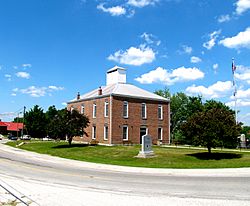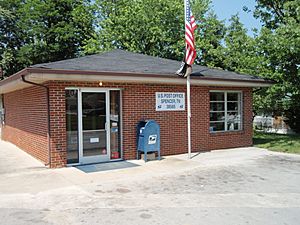Spencer, Tennessee facts for kids
Quick facts for kids
Spencer, Tennessee
|
|
|---|---|

Van Buren County's former Courthouse in Spencer
|
|

Location of Spencer in Van Buren County, Tennessee.
|
|
| Country | United States |
| State | Tennessee |
| County | Van Buren |
| Founded | 1850 |
| Incorporated | 1909 |
| Area | |
| • Total | 6.55 sq mi (16.98 km2) |
| • Land | 6.55 sq mi (16.98 km2) |
| • Water | 0.00 sq mi (0.00 km2) |
| Elevation | 1,798 ft (548 m) |
| Population
(2020)
|
|
| • Total | 1,462 |
| • Density | 223.04/sq mi (86.12/km2) |
| Time zone | UTC-6 (Central (CST)) |
| • Summer (DST) | UTC-5 (CDT) |
| ZIP code |
38585
|
| Area code(s) | 931 |
| FIPS code | 47-70240 |
| GNIS feature ID | 1270985 |
Spencer is a small town in Van Buren County, Tennessee, United States. It's the main town and county seat of Van Buren County. In 2020, about 1,462 people lived there. Spencer is also home to the famous Fall Creek Falls State Park.
Contents
History of Spencer
Spencer got its name from Thomas Sharp Spencer, an early explorer who traveled through the area in the mid-1700s. The town was officially started in 1850 and became an incorporated town in 1909.
In 1942, something special happened: Spencer elected only women to lead the town. This was a big step for women in government!
A college called Burritt College was located in Spencer for many years, from 1848 until it closed in 1939.
Fall Creek Falls State Park: A Natural Wonder's History
In 1937, the U.S. government started buying land around Fall Creek Falls. This land was in bad shape from erosion. The next year, groups like the Works Progress Administration (WPA) and the Civilian Conservation Corps (CCC) began working to fix the forest and build park facilities. In 1944, the National Park Service gave the park to the State of Tennessee.
Millikan's Overlook in the park is named after Glenn Millikan. He was a professor at Vanderbilt University School of Medicine. Sadly, he died in 1947 when a rock fell on him while he was rock climbing.
In 2006, Tennessee bought more land near the park. This was to create a connected area of public land between Fall Creek Falls State Park and Scott's Gulf.
The Fall Creek Falls Inn and Conference Center used to be a place where visitors could stay. It had many rooms and spaces for meetings. The buildings were old, built in the 1960s and 70s. They were closed in 2018 and later torn down. This happened because the state wanted new, modern facilities.
Building the new inn cost more than expected and took longer. It is expected to reopen in late 2021. The new inn will have fewer rooms but will be much more modern.
Local counties were not happy about the old inn closing for so long. They lost money from taxes and many people lost their jobs.
Burritt College: A School's Journey
The idea for a school in Spencer came from Nathan Trogdon, a brick mason. By the late 1840s, a group of leaders formed a board to start the school. In 1848, the state of Tennessee approved the school. It was named after a famous activist named Elihu Burritt. People from nearby counties helped raise money for the school. Classes started on February 26, 1849, with 73 students and three teachers.
The first president, Isaac Newton Jones, set up the school's classes. He left after one year. The next president, William Davis Carnes, made important changes. In 1850, he allowed both boys and girls to attend, which was called coeducation. He also made strict rules about behavior and religion.
Carnes believed that boys and girls should learn together. He said, "It is God's law that the young of the opposite sexes should exert a healthful influence in the formation of each other's characters." To ease worries, he made rules that students of different sexes could only talk in classrooms or supervised events.
Carnes' rules banned swearing, gambling, smoking, and drinking. He tried hard to stop drinking, even expelling students caught with alcohol. He even asked police to find illegal alcohol makers in the area. In 1857, the president's house and the girls' dorm were burned down, possibly in revenge. Carnes then left to lead another university. John Powell became the new president.
The college closed in 1861 when the Civil War began. Many male students left to fight. The college was safe for a while, but then Union soldiers took it over. With Carnes' help, the school briefly reopened in 1864. However, the Union Army closed it again due to fighting in the area. Soldiers used the main building as barracks and dorms as stables. The campus was badly damaged. After the war, the college sold some land to pay for repairs. With Carnes' help, it reopened again. Martin White, a former student, became president. Carnes returned as president in 1872.
In the 1870s, a doctor named Thomas Wesley Brents helped Burritt College raise money. With his help, the campus grew a lot, and a new building was constructed. Brents wanted to be president, which made Carnes resign in 1878. Brents became president for four years. He increased student numbers and updated the classes. However, student numbers started to drop by the time he left in 1882. The school struggled financially and closed in 1889. The leaders decided to reopen it instead of selling the campus.
To help the college, William Newton Billingsley, a Burritt graduate, became president. He improved the school's money situation and increased student numbers to over two hundred by 1899. In 1897, the college had a good income, 164 students, 10 teachers, and three thousand books. The early 1900s were very successful for the school.
On March 5, 1906, the college's main building was destroyed by fire. Students and leaders decided to finish the school year and rebuild. Classes were held in the church and homes. The college closed for several months while a new building was constructed. Despite money problems, the new building was finished in 1907.
Burritt faced problems again after Billingsley left in 1911. New state schools opened nearby, like Middle Tennessee State and Tennessee Tech. The college struggled to find a permanent president until Henry Eugene Scott was hired in 1918. In the 1920s, Scott updated the classes to be more like a high school and junior college. They offered courses in farming, typing, bookkeeping, and teacher training. By the 1930s, Burritt relied on money from the Van Buren County school board. When the school board decided to build a county high school in 1936, Burritt could no longer compete for students. It finally closed in 1939.
Geography of Spencer
Spencer is located at 35°44′37″N 85°27′30″W / 35.74361°N 85.45833°W. The town sits on the western edge of the Cumberland Plateau, just above the Caney Fork river valley. This river forms the border between Van Buren and White County to the north of Spencer.
Spencer is quite isolated because of the mountains and valleys around it. The Cane Creek Valley to the east and Dry Fork Gulf to the south also separate it. Cane Creek, with its many waterfalls, flows north towards the Caney Fork. This area, known for its beautiful waterfalls and rock formations, makes up most of Fall Creek Falls State Park.
Spencer is mainly along State Route 30. This road connects Spencer to Pikeville in the east and McMinnville in the west. State Route 111 goes through the eastern part of Spencer. It connects the town to Sparta and Cookeville to the north, and Dunlap to the south. Spencer is about 30 miles south of Cookeville and 25 miles west of Pikeville.
The town covers about 6.8 square miles of land.
People of Spencer
| Historical population | |||
|---|---|---|---|
| Census | Pop. | %± | |
| 1870 | 147 | — | |
| 1880 | 217 | 47.6% | |
| 1890 | 138 | −36.4% | |
| 1910 | 210 | — | |
| 1930 | 390 | — | |
| 1940 | 508 | 30.3% | |
| 1950 | 721 | 41.9% | |
| 1960 | 870 | 20.7% | |
| 1970 | 1,179 | 35.5% | |
| 1980 | 1,126 | −4.5% | |
| 1990 | 1,125 | −0.1% | |
| 2000 | 1,713 | 52.3% | |
| 2010 | 1,601 | −6.5% | |
| 2020 | 1,462 | −8.7% | |
| Sources: | |||
Spencer's Population in 2020
| Race | Number | Percentage |
|---|---|---|
| White (non-Hispanic) | 1,396 | 95.49% |
| Black or African American (non-Hispanic) | 6 | 0.41% |
| Native American | 4 | 0.27% |
| Asian | 2 | 0.14% |
| Other/Mixed | 31 | 2.12% |
| Hispanic or Latino | 23 | 1.57% |
In 2020, there were 1,462 people living in Spencer. There were 561 households and 363 families.
Spencer's Population in 2010
In 2010, Spencer had 1,601 people living in 632 households. The average household had 2.35 people. Most residents (97.2%) were White. About 1% were African American, and smaller numbers were Native American or Asian. About 0.6% of the population was Hispanic or Latino.
In the households, 29% had children under 18. About 47.8% were married couples. The median age in Spencer was 43.4 years. Women made up 51.2% of the population.
The average household income was about $19,033. About 34.3% of the people lived below the poverty line.
Tourism and Attractions
- Fall Creek Falls State Resort Park is a huge park covering over 26,000 acres. It's famous for its amazing rock formations and beautiful waterfalls. The park's main attraction is Fall Creek Falls, which is 256 feet tall. It is the highest free-falling waterfall east of the Mississippi River.
- Fall Creek Falls: This 256-foot waterfall is a must-see. A short path leads from the parking lot down to the pool at the bottom of the falls.
- Cane Creek Falls: An 85-foot waterfall along Cane Creek. You can see it from the Gorge Trail or from the bottom of the gorge.
- Cane Creek Cascades: A 45-foot series of small waterfalls just above Cane Creek Falls.
- Rockhouse Falls: This 125-foot waterfall joins Cane Creek. It shares a pool with Cane Creek Falls and can be seen from the Gorge Trail.
- Piney Creek Falls: A 95-foot waterfall on Piney Creek. Trails lead to the base of the falls and an overlook above them.
- Coon Creek Falls: A 250-foot waterfall that drops into the Fall Creek Gorge, very close to Fall Creek Falls.
- Lost Creek Falls: A 60-foot waterfall where water comes out of a cave and then disappears into the pool below.
- Cane Creek Overlook: A viewpoint that looks out over Cane Creek Falls and Rockhouse Falls.
- Cane Creek Gorge Overlook: This spot offers views northward across the Cane Creek Gorge.
- Rocky Point Overlook: Located on a cliff, this overlook also provides views northward across the Cane Creek Gorge.
- Millikan's Overlook: Found off the road in the Piney Creek area, it looks northward across the Cane Creek Gorge.
- Buzzard's Roost: A cliff near Millikan's Overlook.
- Rumbling Falls Cave: This cave has the second-largest cave chamber in the United States. It's in the park's Dry Fork section.
- Camps Gulf Cave: Another large cave in the park with very big chambers.
- Lost Creek Cave: This cave has five entrances, a waterfall inside, and about 7 miles of tunnels.
Education in Spencer
The Van Buren County Schools system runs the public schools in Spencer.
Spencer in Arts and Movies
Artist Gilbert Gaul, famous for his Civil War drawings, had a studio south of Spencer. The Gaul's Gallery restaurant at the park's inn was named after him.
Fall Creek Falls State Park has been a filming location for several movies:
- Turbo: A Power Rangers Movie (a fantasy adventure film)
- The Jungle Book (Disney's live-action movie)
- Dr. Otto and the Riddle of the Gloom Beam (a funny science fiction film starring Jim Varney)
- Scenes from the 1986 movie King Kong Lives, starring Linda Hamilton, were filmed near Cane Creek Cascades and Cane Creek Falls.
Notable People from Spencer
Many interesting people have connections to Spencer:
- H. Leo Boles: A preacher and school leader.
- Foster V. Brown: A U.S. congressman.
- Charles Dickens Clark: A U.S. district court judge.
- Andrew Jackson Clements: A U.S. congressman.
- Joe H. Eagle: A U.S. congressman.
- Thomas A. Kercheval: A state lawmaker and mayor of Nashville.
- John W. Preston: A California state supreme court justice.
- Thomas M. Shackleford: A Florida state supreme court justice.
See also
 In Spanish: Spencer (Tennessee) para niños
In Spanish: Spencer (Tennessee) para niños


